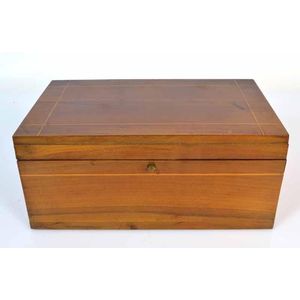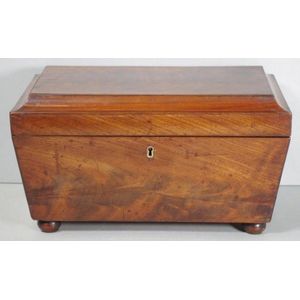Swedish Art Deco Inlaid Bar Cabinet
You must be a subscriber, and be logged in to view price and dealer details.
Subscribe Now to view actual auction price for this item
When you subscribe, you have the option of setting the currency in which to display prices to $Au, $US, $NZ or Stg.
- Inlay - Decorative patterns inserted into the main body of a piece of furniture, generally in wood of contrasting colour and grain, though brass, ivory, ebony, shell and sometimes horn have been used. Inlay may consist of a panel of well figured timber inset into a cabinet door front, geometric patterns, or complex and stylized designs of flowers, swags of foliage, fruits and other motifs. As a general rule, in pieces where the carcase is constructed in the solid, the inlay is relatively simple such as stringing, cross banding and herringbone banding. Where more elaborate and decorative work was required veneer was used. Inlay has been fashionable from at least the latter half of the 17th century, when a variety of elaborate forms were developed
- Bevel / Chamfer - In furniture making, a chamfered corner refers to a technique used to create a smooth, angled edge on the corner of a piece of furniture. This is typically done by cutting away a small portion of the corner at an angle, typically 45 degrees, creating a diagonal edge, rather than a sharp 90-degree angle. This technique can be used on various parts of a piece of furniture such as table legs, drawer fronts, or door frames. Chamfering can add visual interest to a piece and can help to soften the overall look of a piece of furniture. It is often used in conjunction with other techniques, such as rounding edges or using contrasting wood species to create a more elegant, sophisticated look. Chamfering is a simple way to add a touch of elegance to a piece of furniture and it is a common technique used by furniture makers.
- Birch - Birch is a Northern Hemisphere hardwood, closely related to the beech/oak family, and was a timber popular with 18th century craftsmen. Because of the blonde-golden colour of the grain when polished and its close grain, as a veneer it is often used as a substitute for satinwood where cost savings are required. From the late 18th century cabinetmakers in Russia and Eastern Europe used it in the solid for chairs and other furniture.
Karelian birch is birch with a burr grain that resembles marble, from the Karelia region between Finland and Russia. Because only 30% to 40% of seeds result in trees with Karelian birch features, and the fact that it is very slow growing, the timber is very expensive. - Intarsia - When used in relation to wooden items, intarsia is the Italian term for inlaying, where the background timber is cut away and and a selection of timbers of different colours and grains are inserted to form a picture or pattern.
- Art Deco Period - The Art Deco period was a cultural movement that emerged in the 1920s and 1930s, and was characterized by its emphasis on modernism, luxury, and elegance. The name "Art Deco" comes from the Exposition Internationale des Arts Décoratifs et Industriels Modernes, a large exhibition held in Paris in 1925 that showcased the latest trends in decorative arts.
Art Deco was a reaction against the ornate and elaborate styles of the previous era, and reflected a new modern sensibility. It was characterized by streamlined, geometric shapes, bright colours, and the use of new materials such as chrome, glass, and Bakelite. Art Deco designers sought to create a sense of luxury and sophistication, often incorporating expensive materials such as ivory, marble, and rare woods.
Art Deco had a significant impact on a wide range of artistic fields, including architecture, fashion, graphic design, and interior design. Some of the most iconic examples of Art Deco architecture include the Empire State Building in New York City, the Hoover Building in London, and the Palais de Chaillot in Paris.
The Art Deco period came to an end in the 1940s, as World War II and changing cultural trends led to a shift in artistic styles. However, Art Deco remains an important influence on design and art, and continues to be celebrated for its modernist sensibility and glamorous aesthetic.
This item has been included into following indexes:
Visually similar items

A mid 20th century cigar box, rosewood finish with boxwood inlay. Height 11 cm. Length 25 cm. Width 15 cm

Large George III flame mahogany tea caddy, the interior with matching & strung canisters and bowl, with heavy lion ring side handles and bun feet, c1800, 35 cm x 19.5 cm, 20 cm high

Large Regency rosewood sarcophagus tea caddy, the interior with vaulted canisters and cut glass bowl, ornate brass ring handles & ball feet, c1830, 35 cm x 19 cm, 21 cm high

Vintage blanket trunk 107 cm wide, by 51 cm deep, by 62 cm tall
